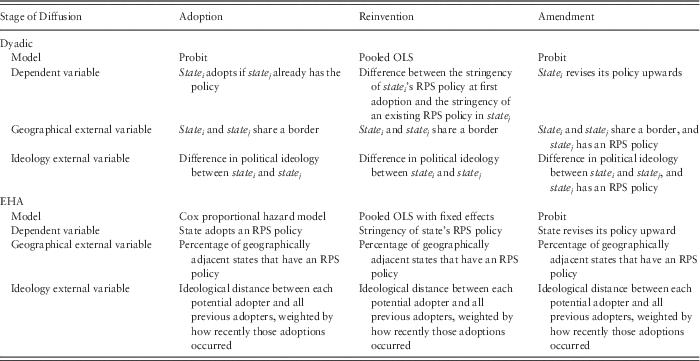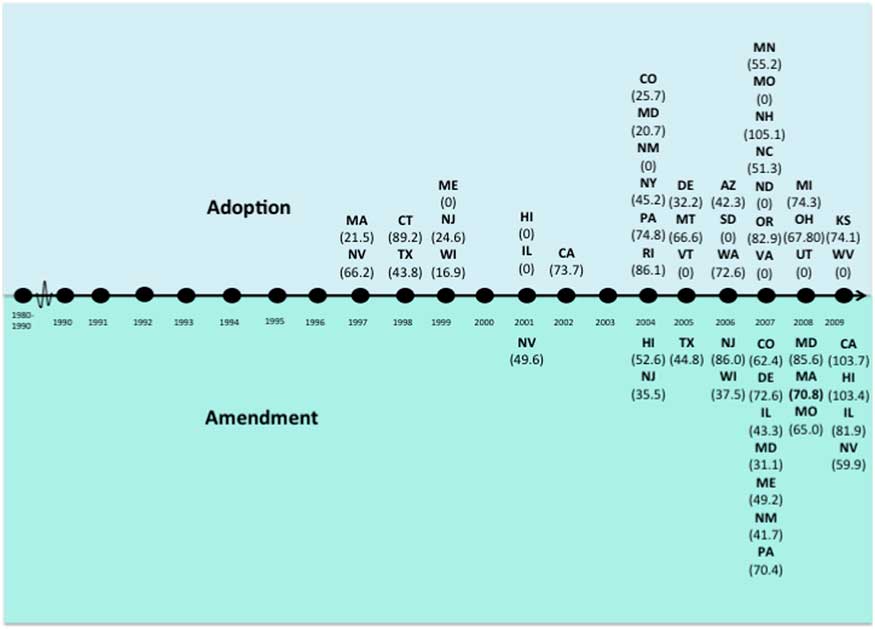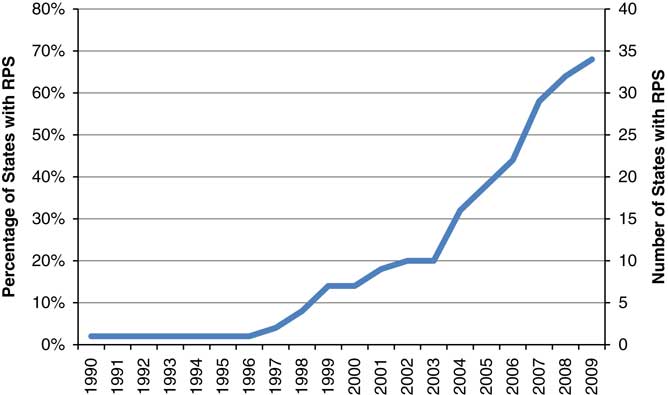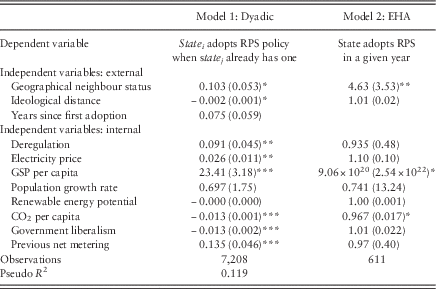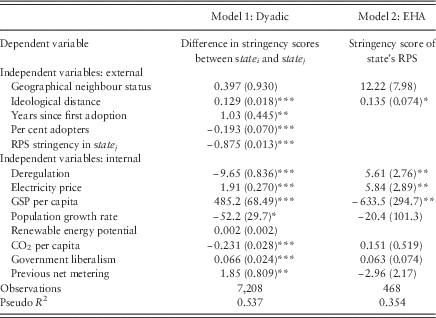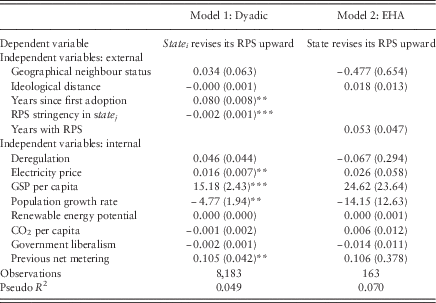The phenomenon of social interaction has long been central to explanations regarding the diffusion of innovations among individuals (see Rogers Reference Rogers1995), and scholars of public policy similarly recognised long ago that governments attempt to learn about the costs and consequences of policies before adopting them (Walker Reference Walker1969; Gray Reference Gray1973). The nuances are often contested: over the years, scholars have debated who potential adopters are most likely to imitate or emulate (Grossback et al. Reference Grossback, Nicholson-Crotty and Peterson2004), the conditions under which they are more likely to seek out policy-relevant information (Nicholson-Crotty Reference Nicholson-Crotty2009) and the relative importance of interstate (i.e. external) influences versus internal political and economic factors (Volden et al. Reference Volden, Ting and Carpenter2008). Nonetheless, the central assertion that governments imitate or emulate one another in some manner during the policy diffusion process is one of the oldest and most consistently validated in the study of public policy.
Relatively quickly after Walker’s seminal work, scholars began to argue that the existing literature had not focussed sufficiently on the content of policies diffusing among governments, and thus had missed one of the key factors in the diffusion process (Rice and Rogers Reference Rice and Rogers1980; Glick and Hays Reference Glick and Hays1991). This line of work also focussed heavily on changes to policies, suggesting that later adopters were likely to alter or “reinvent” innovations based on what they had learnt from the experience of governments that embraced a policy earlier in the diffusion process (see, e.g. Mooney and Lee Reference Mooney and Lee1999). In a related argument, another study has suggested that amendments made after adoption are an important determinant of the final character of a policy and should be considered as part of the larger diffusion process. Here again, scholars have theorised that policymakers’ observations of behaviour in other jurisdictions help to inform these postadoption revisions (see Hays Reference Hays1996a; Lamothe Reference Lamothe2004; Pacheco Reference Pacheco2012).
Interestingly, despite recognising some important differences in the factors that influence adoption, reinvention and amendment, to date scholars have not explored the ways in which the importance of external interstate influences might itself vary across these decision stages. Instead, they have implicitly assumed that interjurisdictional interactions are similar whether a state is considering adopting a class of policy similar to one adopted by neighbours or peers, redesigning a policy before adoption in order to make it better fit the needs of the state or amending an existing policy. This article argues that this assumption lacks empirical support, and may limit our understanding of interstate interactions in the diffusion process. We theorise that the ease of observing policy adoptions in neighbouring states leads to the strong pattern of geographical diffusion noted so frequently in the literature, but that the importance of other, nongeographical types of “peer” states will grow when state policymakers consider how to customise a policy to be compatible with the needs and preferences of their citizenry. Finally, the theory developed herein suggests a diminishing role for external influences during the amendment process, when policymakers can rely more heavily on experience and experimentation internal to their own state for information.
We tested the expectations drawn from these general propositions by examining the adoption, reinvention and amendment of one of the most prevalent renewable energy policies in the American states between 1996 and 2009 – the renewable portfolio standard (RPS). The results broadly support our expectations, suggesting that state policymakers are more likely to adopt some type of RPS if neighbouring states have already done so, but that decisions to increase the stringency of an existing RPS relative to previous adopters are more likely to be emulating ideological rather than geographical peers. Postadoption amendment of an RPS is largely driven by internal characteristics of the state.
Types of decisions in the diffusion literature
The pronounced majority of scholarship on policy diffusion focusses on the initial adoption decision, and it is therefore unsurprising that much of the discussion of interstate or external interactions has taken place in that context. The idea that state policymakers may observe or interact with one another as policies move across jurisdictions grows from the earliest study on the diffusion of innovations among individuals, which suggested that the spread of something new is a social process dependent on communication among users and potential users [see Rogers (Reference Rogers1995) for a review]. Walker (Reference Walker1969) focussed the discussion on governments and policy innovations, and suggested that jurisdictional decisions are driven by both internal state characteristics and information from other states – the latter providing a heuristic cognitive shortcut for policymakers considering an innovation. Later research suggests that this internal/external diffusion model has defined and continues to dominate the study of policy diffusion (Berry and Berry Reference Berry and Berry1990).
Walker (Reference Walker1969) emphasised that state policymakers were most likely to imitate the policy choices of “similar” states, and as a proxy for this similarity he used geographical contiguity. The argument that neighbouring states are likely to share relevant characteristics is an intuitive one, and the empirical research has consistently confirmed that a jurisdiction is more likely to adopt a policy innovation if a higher proportion of its neighbours has done so (see, e.g. Gray Reference Gray1973; Berry and Berry Reference Berry and Berry1990, Reference Berry and Berry1992; Mintrom Reference Mintrom1997; Mintrom and Vergari Reference Mintrom and Vergari1998; Volden Reference Volden2002; Karch Reference Karch2007a). Looking beyond diffusion across adjacent state lines to other criteria of similarity, scholars have also demonstrated that policymakers’ decisions to imitate or emulate show influence from states that are ideological peers (Grossback et al. Reference Grossback, Nicholson-Crotty and Peterson2004; Volden Reference Volden2006), from the federal government (Gray Reference Gray1973; Karch Reference Karch2007a) and from local governments within the state (Shipan and Volden Reference Shipan and Volden2006). Others have explored the degree to which unofficial political actors (i.e. interest groups, professional associations and other policy entrepreneurs) help facilitate social interactions between states (see, e.g. Mintrom Reference Mintrom2000; Balla Reference Balla2001; Haider-Markel Reference Haider-Markel2001). In recent years, scholars have begun attempting to categorise the underlying types of interaction mechanisms, typically described as emulation, learning, competition and coercion (Shipan and Volden Reference Shipan and Volden2008; Graham et al. Reference Graham, Shipan and Volden2013; Jordan and Huitema Reference Jordan and Huitema2014a). Notwithstanding the precise character of the process, however, the central idea that policymakers weighing a policy innovation consider information from other jurisdictions before making an adoption decision remains at the core of policy diffusion theory.
Although adoption versus nonadoption has received the lion’s share of attention, however, it is not the only decision in the diffusion process upon which scholars have focussed. The policy “reinvention” literature looks beyond the adoption decision itself and turns attention to the content of adopted policies [see Rice and Rogers (Reference Rice and Rogers1980) and Allen and Clark (Reference Allen and Clark1981) for early examples; Jacobs (Reference Jacobs2014) and Berry et al. (Reference Berry, Laird and Stefes2015) for more recent examples focussing on renewable energy policy]. This work has grown, indirectly at least, from earlier scholarship exploring the ways in which individuals’ use of new products or ideas differs from the “mainline” innovation (see Rogers Reference Rogers1995). The literature to date suggests that characteristics of a policy itself can affect the degree or rate of policy diffusion (Nicholson-Crotty Reference Nicholson-Crotty2009; Boushey Reference Boushey2010; Makse and Volden Reference Makse and Volden2011; van der Heiden and Strebel Reference van der Heiden and Strebel2012), and that policymakers considering an innovation are concerned not just with the adoption but also with the success of policies in other jurisdictions (see Volden Reference Volden2006; Shipan and Volden Reference Shipan and Volden2014), particularly when a policy is not highly salient and potential adopters are more concerned with achieving substantive policy objectives than with simple political desirability (Karch Reference Karch2007a).
Interestingly, interstate relations lie even more at the heart of the reinvention literature, as compared with studies that focus exclusively on adoption. This is because reinvention is theorised as a systematic process in which later adopters observe the experiences of innovators and make changes to the content or character of the policies they themselves ultimately choose to adopt. Authors have suggested that external influences in this context lead to a growth in the expansiveness or inclusiveness of policies throughout the diffusion period, as later adopters incrementally build on policies adopted earlier in the process (Clark Reference Clark1985). Some have argued that policies become less controversial as more states adopt them – a bandwagon effect allowing later adopters to be more expansive without incurring political costs (Glick Reference Glick1992; Mooney and Lee Reference Mooney and Lee1995). Others, using economic modelling, point to the influence of path dependency and propose that diffusion has “inertia” of its own (Mercure et al. Reference Mercure, Pollitt, Chewpreecha, Salas, Foley, Holden and Edwards2014). Despite these hypothesised mechanisms and the observation of systematic patterns of reinvention, however, this literature has been criticised for failing to develop a strong theoretical argument for the evolution of policies across the diffusion process (see Hays Reference Hays1996a; Karch Reference Karch2007b); indeed, a recent meta-analysis of diffusion research to date found it “piecemeal and disconnected” (Graham et al. Reference Graham, Shipan and Volden2013, 675). We will return to this issue shortly. For now, it is sufficient to note that external influences have been a central part of the explanation that scholars have posited not only for the spread of policies across jurisdictions but also for the evolution of those policies within the diffusion process.
Some students of policy diffusion, and particularly of reinvention, have also noted a third stage in the diffusion process that can have significant consequences for the character of public policies. This occurs when governments that have already adopted a policy subsequently make changes or amendments to it (see Glick and Hays Reference Glick and Hays1991; Hays 1996Reference Haysa; Jordan and Huitema Reference Jordan and Huitema2014b). Again, interstate interactions are hypothesised to be an important part of the process, but in this case it is early innovators who will gather information from laggards and subsequently make changes to the content of their policies to bring them more in line with those adopted later in the diffusion period.
Perhaps surprisingly, the amendment process has received relatively little empirical attention among the majority of diffusion scholars (for exceptions, see Lamothe Reference Lamothe2004; Pacheco Reference Pacheco2012). This therefore poses many questions that have yet to be resolved. For example, Biesenbender and Tosun (Reference Biesenbender and Tosun2014) find that amendment – which they term “accommodation” and measure as binary, not a matter of degree – faces greater obstacles than initial adoption, whereas Upham et al. (Reference Upham, Kivimaa, Mickwitz and Åstrand2014) contend that initial innovations face greater obstacles due to policy inertia, and the path of least resistance is to expand and reframe (i.e. reinvent and amend) a “niche” policy for new purposes.
Policy influences at different stages of the diffusion process
The literature under discussion suggests that scholars (1) have identified distinct decision stages in the diffusion process, and (2) consider external influences to be an important explanation for behaviour in each. However, despite recognising that adoption, reinvention and amendment are distinct and may be driven by unique factors, research to date has not offered a theoretically grounded argument about the ways in which external influences might be expected to vary across those decision processes. This is particularly interesting because previous studies have hinted at the fact that such variation exists. For example, Glick and Hays (Reference Glick and Hays1991) note in their study of living wills that geographical proximity seemed to have a larger impact for early adopters as compared with those who took up a policy later in the diffusion period, and that, in these early stages of geographical diffusion, states were more likely merely to copy the policies of their neighbours rather than adapt or “reinvent” them. Nonetheless, scholars have not examined how external influences may change across the decision stages of the diffusion process, and whether there are systematic differences in external mechanisms depending on whether policymakers are simply copying a neighbouring state’s policy, modifying a policy that has already diffused to other states or amending a policy previously adopted. Graham et al. call particular attention to the temporal aspects of the diffusion process, describing its nuances as “relatively unexplored” (Reference Graham, Shipan and Volden2013, 699).
In this section, we take steps to address this omission by offering a theory of external interaction and influence throughout the diffusion process. Our argument turns on the amount and types of information decisionmakers need to gather depending on the type of policy-related decision they are attempting to make. As noted above, the literature on diffusion often separates such information gathering into distinct categories, including simple imitation of existing policy, learning from previous adopters, and internal experimentation to reveal the costs and benefits of a particular policy choice. These categories align well with the three stages of the diffusion process and, we believe, can point us to the relative importance of external and internal influences on those stages.
In cases where imitation dominates, simply knowing that another state has adopted a policy is sufficient to motivate potential adopters to do the same. Examples of such cases would be found when state policymakers need to adopt policies quickly in response to high issue salience or strong political pressures (van der Heiden and Strebel Reference van der Heiden and Strebel2012). Similarly, imitation will be present when state policymakers are uninterested in making, or lack the capacity to make, substantive changes to the policies being adopted in other states (Shipan and Volden Reference Shipan and Volden2008). Finally, notwithstanding valid criticisms of the modal diffusion study for treating all adoptions as identical (see Karch Reference Karch2007b), there are times when the substantive core of a policy idea diffusing across the nation (e.g. same-sex marriage or marijuana legalisation) is essentially the same despite technical differences among policies adopted in different states (e.g. different licensure requirements or tax levies).
In cases of imitation, or simple adoption, then, the behaviour of geographical peers should be particularly influential. Sharing a border increases the level of knowledge that policymakers in each government have about the other via a set of relatively intuitive mechanisms. States that share a border are more likely to be embedded in the same policy networks – for example, due to the higher incidence of interstate relationships (Mintrom and Vergari Reference Mintrom and Vergari1998). In addition, many interest groups in the United States (US) have a regional focus, and thus are likely to share knowledge about innovations among geographically proximal states (Haider-Markel Reference Haider-Markel2001; Shipan and Volden Reference Shipan and Volden2008). Finally, if policy choices are in part motivated by interjurisdictional competition, state policymakers have incentives to pay greater attention to neighbouring states, on the grounds that calculating firms or citizens will most easily be able to move there (van der Heiden and Strebel Reference van der Heiden and Strebel2012).
Owing to these connections, we hypothesise the following:
H1: The importance of geographical proximity will be particularly significant when focussing exclusively on the adoption decision.
We are not arguing that ideological proximity does not matter in simple adoption decisions. Indeed, plenty of existing research suggests that it does. We are simply suggesting that the ease of observing the policies adopted by neighbours will make those peers more influential in this case.
In those cases where there are significant and substantive differences in the policies that diffuse from one state to another, the information gathering process, and hence the external influences on adoption decisions, should be different. Such changes often occur as a result of policy reinvention, or the process by which states “adapt and change an innovation as it diffuses” in response to “such conditions as need for the policy, public support for the policy, [and] the political and ideological cleavages that may divide state political institutions” (Hays Reference Hays1996b, 564). In other words, rational policymakers often adopt an altered form of an innovation, rather than simply mimicking the exact policy that others have chosen. Policy instruments are not “stable blueprints for action” (Voss and Simons Reference Voss and Simons2014, 735); they evolve as they migrate across jurisdictional contexts. When potential adopters consider adapting a policy from other states to their own needs, they cannot simply imitate, but must instead consider the costs and benefits of an innovation.
State policymakers attempting to gather such information should be particularly interested in the behaviour of states that are politically similar to themselves, for multiple reasons.Footnote 1 First, insofar as reelection is an important motivation for state-level officials responsible for policy adoption (Mayhew Reference Mayhew1974), then the political costs, benefits and opportunities of a potential policy are likely to be a prominent factor in the adoption decision (Biesenbender and Tosun Reference Biesenbender and Tosun2014). As such, when an Alabama legislator considers whether to adopt a requirement of background checks for sales at gun shows, she can learn more about the potential electoral consequences of that decision by looking at what happened after Oklahoma adopted the same law than she could by studying the electorate’s response in Massachusetts.
Policymakers may also look to adoptions by political peers when considering an innovation, because doing so gives them a better idea of the degree to which the policy that is already diffusing matches their preferences. Grossback et al. (Reference Grossback, Nicholson-Crotty and Peterson2004) developed a theoretical argument as to why this should be the case, suggesting that policymakers wish to maximise the degree to which any adopted policy matches their ideological preferences because doing so helps to (1) produce the policy outcome that they prefer and (2) make the policy popular among their constituents. Unfortunately, policymakers lack reliable information about the exact position of most innovations in the policy space, and face corresponding difficulties in accurately assessing any given proposal’s proximity to their ideal point(s). The adoption of a policy in an ideologically similar state, suggest the authors, therefore provides an information shortcut that can compensate for that lack of policy-specific knowledge. They also argue, importantly, that state policymakers are likely to follow their ideological peers because they know that doing so provides more accurate policy-relevant knowledge than does following neighbours.
It has only been tested to date in studies of policy adoption, but we believe that the information available from ideological peers should be particularly important in the policy-reinvention process. General familiarity with a policy may well come from adoptions in neighbouring states, but one may logically expect that state policymakers will closely consider the ideological orientation of previous adopters when making decisions about the specific attributes of a policy that are compatible with their preferences and those of their constituents. We expect, therefore, the following:
H2: The importance of ideological proximity to previous adopters will be particularly significant when focussing on policy reinvention, that is, adaptations to an innovation made throughout the diffusion process.
The final stage of the diffusion process in which we are interested is postadoption amendment. In many ways, amendment is similar to the concept of reinvention in that it involves adaptation of existing policy in order to make it better fit the needs or preferences of a state. The key difference, however, is that in the case of amendment the state has the opportunity to experience and experiment with a policy directly (Jacobs Reference Jacobs2014), rather than simply observe the experiences of other states. In the traditional conception of diffusion, learning from the experiences of previous adopters is offered as a substitute for the experience that decisionmakers lack regarding a particular policy. Recent formal models of the diffusion process suggest that states given the opportunity to experiment with a policy will make final decisions based on the results of those experiments, regardless of whether they are also given the chance to observe behaviour in other states (Volden et al. Reference Volden, Ting and Carpenter2008). Logically, this suggests that when policymakers do have the opportunity to experiment with a policy on their own – which by definition is greater in the period between adoption and amendment than in the period before initial adoption – the importance of experiences in other jurisdictions may diminish.
As a result, we expect the following:
H3: Intrastate influences will play a more important role in amendment decisions, relative to other stages in the diffusion process.
An empirical examination of external influences throughout the diffusion process
We test the propositions outlined above in the analyses of state-level adoption, reinvention and amendment of RPS policies between 1996 and 2009. Many recent state policy efforts in the energy arena have focussed on and supported innovative approaches to increasing energy production from renewable energy sources. To date, 45 states have adopted renewable policies of some kind, with the RPS among the most prevalent. Renewable energy development including RPS involves a degree of uncertainty that leads it to be perceived as complex and risky, and correspondingly prone to political controversy (Tylock Reference Tylock, Seager, Snell, Bennett and Sweet2012). However, RPS policies are one of the most popular state-level renewable energy policies and generally rank among the highest of all policy options for stakeholder support in states’ climate action plans.Footnote 2 As such, these policies provide a good opportunity to study external influences because lawmakers have both the need – due to the complexity – and the incentive – due to the salience and the risk – to consider them.
An RPS is a hybrid command-and-control and market-based policy instrument that mandates that a certain percentage or amount of electricity within a state must be generated from renewable sources such as wind, solar, geothermal or biomass. The deployment mandate is graduated over time (e.g. 15% of electricity production from renewables by 2025, with incremental goals along the way), and compliance typically incorporates traditional command and control mechanisms, such as monitoring and sanctioning, along with the trading of credits in order to increase flexibility for implementing jurisdictions.
There is a growing literature on the adoption of RPS and other renewable energy policies. In some cases, this study has uncovered consistent predictors of the adoption of these policies. For example, multiple scholars have found reliable influence on adoption from political ideology, measured via either citizen preferences or partisan legislative control (Huang et al. Reference Huang, Alavalapati, Carter and Langholtz2007; Matisoff Reference Matisoff2008; Stoutenborough and Beverlin Reference Stoutenborough and Beverlin2008; Chandler Reference Chandler2009; Lyon and Yin Reference Lyon and Yin2010; Carley and Miller Reference Carley and Miller2012; Yi and Feiock Reference Yi and Feiock2012; Matisoff and Edwards Reference Matisoff and Edwards2014; Berry et al. Reference Berry, Laird and Stefes2015), and from state affluence, measured through either total gross state product (GSP) or GSP per capita (Huang et al. Reference Huang, Alavalapati, Carter and Langholtz2007; Matisoff Reference Matisoff2008; Chandler Reference Chandler2009; Wiener and Koontz Reference Wiener and Koontz2010). In other cases, however, conclusions regarding the drivers of renewable energy policy have been inconsistent, or even contradictory. For example, multiple studies have found renewable potential (e.g. high capacity for solar or wind energy production) to be meaningful for policy adoption under some conditions (see, e.g. Matisoff Reference Matisoff2008; Lyon and Yin Reference Lyon and Yin2010; Yi and Feiock Reference Yi and Feiock2012), whereas others have found that capacity has no effect on adoption decisions (Carley and Miller Reference Carley and Miller2012), and one study of International Energy Agency nations found that increased renewable potential actually reduces the likelihood of policy amendment, as distinguished from initial adoption (Schaffer and Bernauer Reference Schaffer and Bernauer2014). Similarly, Chandler (Reference Chandler2009) found geographical diffusion to be a significant factor in states’ decisions to adopt energy policies, while Matisoff (Reference Matisoff2008), Stoutenborough and Beverlin (Reference Stoutenborough and Beverlin2008), Yi and Feiock (Reference Yi and Feiock2012) and Carley and Miller (Reference Carley and Miller2012) did not. Despite these inconsistencies, the existing literature on RPS suggests some important control variables that we will discuss in greater detail shortly.
Estimation strategy and dependent variables
We adopt a dual modelling approach to evaluate the question of implementation and policy learning in the adoption of RPS policies. First, we use a dyadic approach, in which we model directed dyads composed of all states (50 theoretically) paired with all other states (49 theoretically) from which they might gather policy information. The dyadic approach is gaining popularity in recent research as an alternative to the event history analysis (EHA) approach to studying policy diffusion (see, e.g. Volden Reference Volden2006; Gilardi and Füglister 2008; Gilardi Reference Gilardi and Füglister2012), based on the argument that it allows for a more direct test of hypotheses regarding the conditions under which one state learns from another. A dyadic analysis allows the researcher to observe directly whether the policy in state i changes to align with the policy in state j , controlling for the characteristics in each state and the characteristics that they share. Alternatively, because of the panel structure of the data, EHA can only show whether the policy in state i changes to reflect the policy choices of a group of expected exemplars, where that group is defined by the shared characteristics believed to facilitate policy emulation.
As an example, dyadic analysis can demonstrate a correlation between the adoption of a policy in Missouri and the adoption of a similar policy in Arkansas. Alternatively, EHA can only show a correlation between adoption in Missouri and the proportion of Missouri’s neighbours, potentially including Arkansas, that have adopted a similar policy. Similarly, the dyadic approach can tell us directly whether the ideological similarity between those two states influences diffusion of a policy from one to another, whereas the EHA approach can only tell us the influence of the ideological distance between Missouri and the average of all previous adopters.
Second, we employ a traditional panel EHA approach where the state-year is the unit of analysis – or, in the case of the amendment model, a modified panel EHA approach – in order to make our results more directly comparable with other studies, as well as to serve as a test of robustness of the dyadic results. As just explained, however, it is important to bear in mind that these two models test different phenomena. The two approaches also necessitate that we use two separate data sets. The EHA approach uses a standard state-year data set, which contains all 50 states, before dropping observations as described below, from 1997 to 2009. In the dyadic model, the unit of analysis is the dyadic pair and the data set represents dyadic pairs by year. This, of course, significantly increases the sample size of the dyadic model over the EHA model.Footnote 3
As is standard for this type of analysis, we drop the initial adopters in the modelling of the adoption and reinvention processes, based on the assumption that these states initiated the diffusion process and were not influenced by the behaviour of other states. In keeping with this convention, we drop Massachusetts and Nevada, the first RPS adopters. Even though the diffusion period for modern RPS began at that point, we also drop Iowa, which adopted a policy that loosely resembles an RPS, referred to as an alternate energy production requirement, in 1983. We follow this convention for both data sets. In the amendment models, we are interested only in adjustments made after the initial policy has been adopted. As a result, the states enter the sample only after they have adopted and remain in the sample until the end of our time frame, because states can theoretically amend their policies multiple times, and we find that many do just this. The analysed sample in this case does not exclude initial adopters but it does exclude those that never adopted the policy.
We use several dependent variables in this analysis in order to (1) accurately operationalise the different stages of the diffusion process, and thus test the guiding hypotheses offered above, and (2) use measures that are appropriate to our two different data sets. In the dyadic analyses of diffusion, dependent variables capture not just adoption or some other policy-related behaviour in state i but also the degree to which that behaviour moves state i towards the policy condition in the other state within the dyad, or state j . In the EHA models, the dependent variables are specific to activities that occur within state i , such as whether the state adopts an RPS policy.
In the dyadic adoption model, we use a policy adoption variable coded as 1 if state i adopts an RPS policy at time t and state j already had the policy at time t−1 and 0 otherwise. Once both states in a dyad have adopted an RPS policy, the dyad is dropped from the analysis, because there is no longer the possibility that either can move towards the policy of the other. In the EHA adoption model, we use a simple measure that equals 1 when the state adopts an RPS policy and 0 otherwise. For both versions of the model, the RPS is assumed to be present in a state on the date by which it is registered as effective. Voluntary policies are also coded to equal 1.Footnote 4 The RPS policy data are extracted from the Database for State Incentives for Renewables and Efficiency (DSIRE) (NC Clean Energy Technology Center 2011).
For our second hypothesis, regarding external influences on policy reinvention, we must model the ways in which RPS policies change throughout the diffusion period. In a meta-analysis of the diffusion literature to date, Graham et al. (Reference Graham, Shipan and Volden2013) advocated for more fine-tuned measures of policy change in order to capture the details of policy evolution. There are a number of differences between the policies of early and late adopters on which we might focus, but previous research suggests that the stringency of adopted policies has shown the most meaningful change during RPS diffusion. Indeed, Carley and Miller (Reference Carley and Miller2012) suggest that simple binary measures of RPS adoption may be misleading and they found that policies with different levels of stringency – ranging from voluntary participation to rigorous and strictly enforced targets with full utility-sector engagement – are motivated by systematically different underlying factors.
To determine a stringency index for the RPS, we follow the method applied by Carley and Miller (Reference Carley and Miller2012), refining the work of Yin and Powers (Reference Yin and Powers2010). The resultant formula incorporates the mandated change in renewable energy levels over time relative to the policy’s baseline, divided by the mandated time span for changes to be implemented, all prorated by the percentage of a state’s generating load covered by the policy:
For example, suppose a state has a 25% mandate that must be achieved between 2008 and 2020, and the RPS policy pertains only to investor-owned utilities in a state, which collectively supply 90% of the state’s generating load. This state starts at 0% renewable energy in 2007. The stringency score for this state would therefore be 25 divided by 12, multiplied by 90, for a total of 188.Footnote 5 All states with voluntary policies are necessarily coded with a stringency value of 0. The policy data used to derive the stringency scores are also taken from the DSIRE database.
In the context of the dyadic model, we are interested in the degree to which one state in the dyad adjusts its stringency to be more (or less) similar to the stringency of the other state. Thus, the dependent variable for this model is the difference between the stringency of state i ’s RPS policy at first adoption and the stringency of an existing RPS policy in state j . If state j does not have an RPS policy, the variable takes on a value of 0 because state i cannot reinvent that particular state’s policy. Again, once both states in the dyad have adopted a policy, they are dropped from the analysis. Note that this model, therefore, does not track how state i ’s RPS policy changes over time, but rather considers the stringency of state i ’s RPS policy in the year in which the policy is first adopted, as a single instance of an ongoing multistate process. This construction appropriately matches the conceptualisation of reinvention offered in the literature to date (Glick and Hays Reference Glick and Hays1991; Karch Reference Karch2007a). The measure is directional, with positive numbers reflecting a more stringent policy.
For our third hypothesis, to test for the impact of external factors on postadoption policy amendment, we use the same measure for both models. This dependent variable represents whether state i revises its RPS policy to a higher stringency during the study period. Each year in which the state revises its policy upwards, it is coded as a 1.Footnote 6
The statistical models that we use vary across the adoption, reinvention and amendment analyses, as well as across the two data sets. For the adoption model, we estimate a probit model with clustered standard errors for the dyadic approach and a Cox proportional hazard model with the EHA data, where the predicted “failure” event is RPS adoption. For the panel data EHA reinvention model, we use a pooled ordinary least squares regression with robust standard errors and fixed effects for year and state. For the dyadic reinvention model, we use pooled ordinary least squares with dyad-pair clustered standard errors. To evaluate amendment, we use a probit model with both the dyadic and the state-year data, all with robust standard errors. All dyadic models implement the Boehmke (Reference Boehmke2009) correction, which avoids bias by conditioning on the opportunity to emulate. In other words, dyads are only included in the analysis once one of the partners has adopted, and thus the opportunity for the other to emulate that adoption has arisen.
As we choose to present two sets of models for each stage of the diffusion process in order to check the robustness of our results, and each of these six models tests a different thing, it results in a number of different variable constructions. To help document these differences, we include Table 1, which tracks the methodological approach, dependent variable and two external influence diffusion variables across the six model specifications. The manner in which these variables are coded is explained in greater detail below.
Table 1 Unit of analysis and stage of diffusion differences

Note: OLS=ordinary least squares; RPS=renewable portfolio standard; EHA=event history analysis.
Independent variables
External influence variables
The hypotheses offered above are primarily concerned with the influence of different external factors at different stages of the diffusion process. For all models, we include two general external influence variables: a measure of geographical proximity and a measure of ideological similarity. The way in which we operationalise these measures, however, varies across the models and data sets, just as is the case with the dependent variables. For the dyadic adoption and reinvention models, the geographical proximity variable is operationalised as whether state i and state j share a border. For the dyadic amendment model, where the dependent variable does not measure how state i responds to state j ’s activities, it is necessary to include external diffusion variables that not only account for a peer relationship between the two states but also document whether state j has a policy. Thus, the geographical diffusion variable in this model documents whether the states share a border and state j already has an RPS. In the EHA models, the geographical proximity measure is more traditional, measuring for each state the percentage of geographically adjacent states that had an RPS policy in the previous year.
The ideological distance diffusion measure in the adoption and reinvention dyadic models is the difference between the political ideology score for state i and state j , using the Berry et al. (2010) measure of government ideology for both states. In the dyadic amendment model, this variable still measures the ideological score difference between the two states but also represents whether state j already has an RPS policy. This variable construction is parallel to that used for the geographical proximity in the amendment dyadic models. For the three EHA models, the ideological diffusion variable measures the ideological distance between each potential adopter and all previous adopters, weighted by how recently those adoptions occurred. We subtract this raw score from 100 in order to create a distance measure that is positively correlated with the probability of adoption. In other words, we expect lower values, which represent greater ideological distance from previous adopters, to be associated with lower probabilities of adoption.
Control variables
The extant literature on state-level renewable energy policy adoption, reviewed briefly in the previous section, informs our choice of control variables. These reflect the internal influences on policy decisions within state i in both the dyadic and the EHA models.
The first set of controls captures the standard internal economic and demographic determinates of adoption. We include a measure of electricity market deregulation based on Delmas et al. (Reference Delmas, Russo and Montes-Sancho2007) and the annual average real price of electricity in each state based on Energy Information Administration (EIA) data (US EIA 2015). Models contain population growth rates for each state i from the annual Census Bureau data (US Census Bureau 1999, 2009) and GSP per capita derived from the Bureau of Economic Analysis (BEA) data (BEA 2010).Footnote 7
A final economic variable captures state i ’s renewable energy potential. It is operationalised as the summation of wind and solar potential, combined into a single measure, expressed in GWh/year.Footnote 8 Wind potential is based on measurements of the available windy land area, after exclusions, with a capacity factor of 30% at a height of 80 m above ground (Department of Energy 2011). Solar potential represents average solar radiation measured over a 30-year span, 1961–1990, for a south-facing flat-plate collector, with 0° tilt, multiplied by the total area within each state’s boundaries and the number of sunny days per year (National Renewable Energy Laboratory 1991).
For internal political influences, the literature suggests a focus on ideology, interest group strength and policy expertise. We capture state-level political ideology in state i with the Berry et al. (2010) measure of government ideology, which is a continuous variable that ranges from 0 to 100. We use carbon dioxide (CO2) emissions per capita (Environmental Protection Agency 2010) as a measure of interest group strength. This variable is a validated proxy for the strength of the fossil fuel industry within a state, which traditionally opposes stringent RPS and other renewable energy policies. We measure policy expertise as state i ’s previous experience with related policies. In keeping with Yi and Feiock’s (Reference Yi and Feiock2012) finding that previous adoption of other energy policies encourages further adoption of complementary instruments, we include a binary variable for the adoption of another very common renewable energy policy – net metering. Net metering allows small-scale energy system owners to connect their system to the electric grid, and give and take electricity as needed.
Finally, we include two additional variables in the dyadic models that do not reflect internal influences in state i . The first of these is the previous year’s stringency value in state j. This variable captures the degree to which it will be feasible for state i to move close to the policy of state j , regardless of geographical or ideological proximity or other factors. In other words, if state j has an extremely stringent policy, the distance between state i and state j will likely be bigger, regardless of other factors. Second, we include the number of years since the first state to do so adopted an RPS policy. Previous studies of reinvention suggest that we should see a convergence in policy characteristics as the diffusion period progresses. For example, Glick and Hays (Reference Glick and Hays1991) suggest that nursing home regulations became more stringent farther into the diffusion of that policy, and Voss and Simons (Reference Voss and Simons2014) found that particular forms of emissions trading policies become strengthened over time as they travel across jurisdictions. As a result, we expect that adopted RPS policies will get more stringent as time progresses, regardless of the impact of internal and external influences on adoptions. In addition and as is standard, the dyadic model accounts for the underlying influence of time with the inclusion of a year spline.
All independent variables are lagged one year in order to account for the time it takes for policymakers to gather and digest information from states they may wish to imitate or emulate and to gather data about policies they have already adopted.
Results
Descriptive statistics for the full sample are presented in the online supplementary Table A.1. Figure 1 gives a timeline similar to that presented in Wiser et al. (Reference Wiser, Namovicz, Gielecki and Smith2007) that displays all policy adoptions on the upper half of the timeline and all amendments on the lower half of the timeline. Both initial adoptions and revisions are listed with their stringency scores in parentheses. This figure demonstrates that 34 states adopted an RPS policy during the study period, 23 of which included nonvoluntary requirements at the time of adoption. A total of 20 states revised their policies in a way that altered the stringency score either once or on several occasions throughout the study period. Figure 2 presents the rate of RPS adoption across states. The policy diffusion approximates a standard s-shaped policy diffusion path.
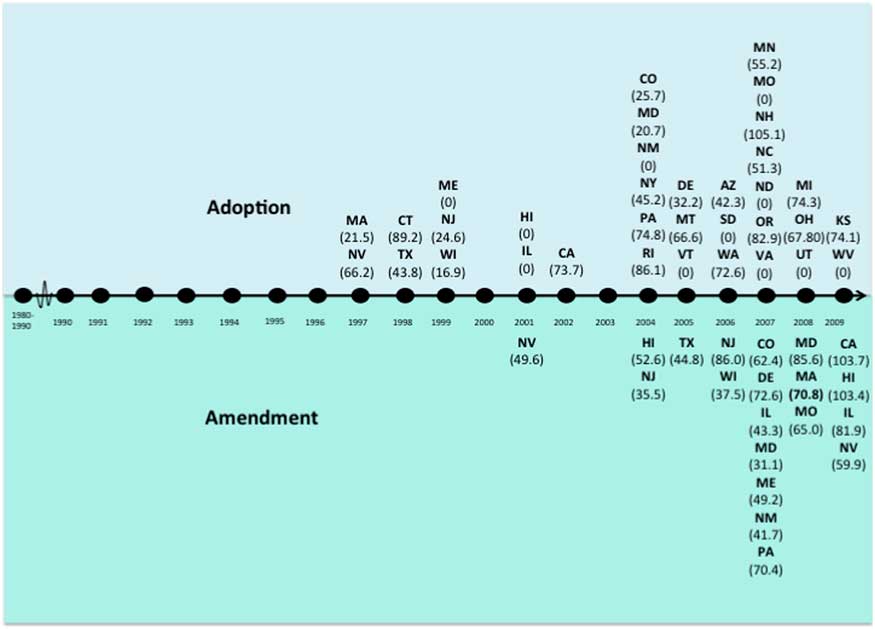
Figure 1 Timeline of renewable portfolio standard policy adoptions and amendments
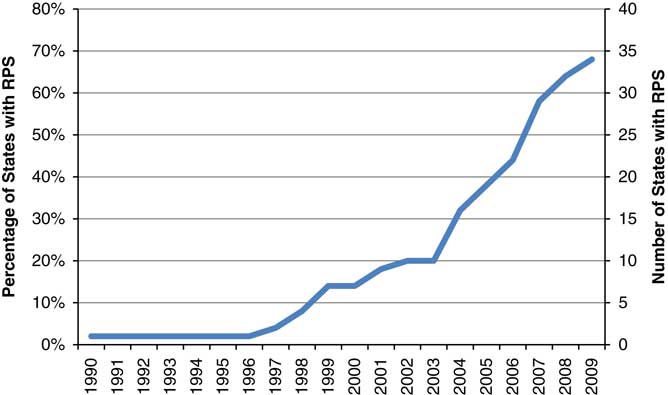
Figure 2 Cumulative adoption of renewable portfolio standard policies over time
Model results are presented in Tables 2, 3 and 4. Table 2 contains results on policy adoption, Table 3 on reinvention and Table 4 on amendment. As noted above, our strategy in these analyses is to present findings from a dyadic model and then discuss results from a more traditional event history approach in order to confirm the robustness of the primary findings.
Table 2 Renewable portfolio standard (RPS) policy adoption
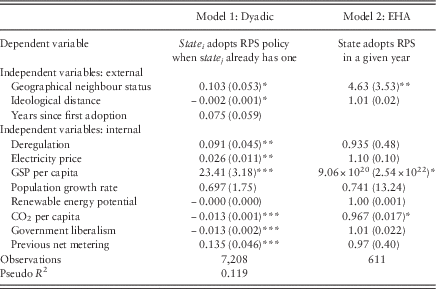
Note: Standard errors are in parentheses.
EHA=event history analysis; GSP=gross state product.
***p<0.01, **p<0.05, *p<0.1.
Table 3 Renewable portfolio standard (RPS) policy reinvention
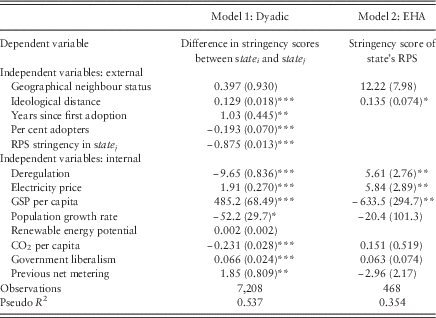
Note: Standard errors are in parentheses.
EHA=event history analysis; GSP=gross state product.
***p<0.01, **p<0.05, *p<0.1.
Table 4 Renewable portfolio standard (RPS) policy amendment
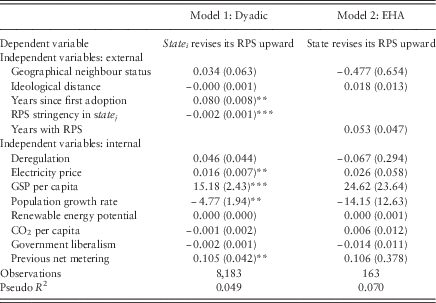
Note: Standard errors are in parentheses.
EHA=event history analysis; GSP=gross state product.
***p<0.01, **p<0.05, *p<0.1.
Table 2 presents the results from the analyses of adoption. Looking first at the dyadic model in Column 1, the results reveal, as hypothesised, that geographical peer influence is a significant predictor of a state adopting an RPS policy when its peer already has one. Substantively, the results suggest that state i is 0.02 more likely to adopt an RPS policy when a neighbouring state (state j ) has done so. Consistent with expectations, ideological similarity between a dyadic pair is also significantly related to the likelihood of adoption. More precisely, the results suggest that state i has a 0.01 lower probability of moving towards the RPS policy choice of state j when the ideological distance between the two increases by 1 SD. Internal factors associated with a state adopting an RPS when its peer already has one in the dyadic analysis include the price of electricity, whether a state’s electricity market is deregulated, whether it has previously adopted a net metering policy, higher levels of liberalism, greater GSP per capita and lower levels of CO2 per capita or, alternatively conceived, lower fossil fuel industry presence. These results are consistent with previous studies on RPS adoption, which is noteworthy in particular because the construction of the dependent variable in the present analysis differs somewhat from those used previously due to the dyadic nature of our data.
We can turn now to the more traditional EHA of RPS adoption presented in Column 2 of the Table 1. The results confirm that the behaviour of geographical peers has an important influence on adoption decisions, with states becoming 4.6 times as likely to adopt the policy if all of their neighbours have done so. In this specification, the measure of ideological distance captures the difference between a potential adopter and all previous adopters, weighted by the recency of those adoptions. However, it fails to reach traditional levels of statistical significance.
The reinvention models, presented in Table 3, are also consistent with our hypotheses, which predict that similarities in political ideology will be the most important external factor driving reinvention. Looking first at the dyadic analysis in Column 1, it is important to remember that the dependent variable in this case is the relative stringency of state i ’s RPS policy when compared with state j ’s policy. The measure is directional, with positive numbers reflecting a more stringent policy. We see a statistically significant estimate for the ideological proximity variable, which is also directional, suggesting that state i adopts a more stringent policy than state j as the former becomes increasingly more liberal than the latter. The geographical peer’s variable, measuring whether state i and state j share a border, is not statistically significant, suggesting that a state’s decision about the stringency of its RPS policy is not informed by the stringency of its neighbours’ policies, all else equal. The control variables again perform intuitively, suggesting that wealthier states and states with more liberal governments were likely to adopt more stringent policies than their dyadic partners, whereas those where the fossil fuel industry is more influential adopted relatively less ambitious policies.Footnote 9
The EHA presented in the second column of Table 3 produces similar results regarding the external factors that influence the reinvention of RPS policies throughout the diffusion process. The dependent variable in this case is simply the stringency of the policy adopted in each state, and the model contains fixed effects for both state and year. These findings suggest that states that are 1 SD more liberal than previous adopters adopt a policy that is 0.14 SD more stringent than the median at the time of adoption. The variable capturing the proportion of a state’s neighbours that had adopted an RPS again fails to reach traditional levels of statistical significance.
In the amendment model, results confirm our expectation that internal characteristics are particularly important in the decision to amend one’s own policy. In this case, both the dyadic and the traditional panel data EHA models use the same dependent variable. Both models include only the sample of states that adopted an RPS policy during the study period. The key result is that, in both models, the measures of geographical and ideological peer influence are statistically indistinguishable from 0.
In the dyadic model, the variable measuring years since the state adopted its RPS is statistically and positively associated with the likelihood of amendment. This provides evidence for the argument that states learn from their own experience with a policy when deciding on postadoption changes. It is also consistent with previous studies suggesting that early adopters of a policy will likely adjust their laws to converge with those adopted later in the diffusion period. The model also suggests that wealthier states and those that had previously adopted a net metering policy were more likely to amend their RPS policies.
Discussion and conclusions
This study began with the assertion that there is value in differentiating the process of policy diffusion into discrete stages of adoption, reinvention and amendment, because doing so might offer theoretical leverage on questions of external influences on policy diffusion. We also argued that we should find that these influences will play stronger or weaker roles at different stages of the process, as policy diffusion is inextricable from policy evolution.
The results presented herein support both these assertions, and justify a need to revisit the scholarship emphasising the distinct decisions that shape the policies adopted and implemented in a state. It has been decades since authors began making the argument that adoption, reinvention and amendment were not the same decision (see Rice and Rogers Reference Rice and Rogers1980; Glick and Hays Reference Glick and Hays1991), but a recent review suggests that the idea has gained very little traction in the diffusion literature (Karch Reference Karch2007b). Those authors were, in fact, suggesting that “adoption” was just an oversimplification of the “reinvention” process that states went through as they considered and adopted a policy. It is not merely plausible but logically necessary that these are in fact distinct sequential decisions, as lawmakers first decide that they want a general class of policy, then decide what the specific characteristics of that policy should be and, finally, make adjustments to the policy after adoption. Without acknowledging this sequence, there is little theoretical foundation for explaining the evolution of policies as they diffuse over time.
More specifically, our findings provide considerable support for our hypotheses regarding the differential impact of external influences across the stages of the diffusion process. Different external variables do indeed emerge as significant depending on whether we are studying the adoption, reinvention or amendment decision. First of all, as expected, policies adopted in neighbouring states correlate positively with simple yes-or-no decisions about a particular class of policy: in this case, the RPS. In our dyadic model, the behaviour of ideological peers also has a significant impact on simple adoption decisions, although that measure is not statistically significant in the more traditional panel data EHA.
These results suggest that, if we look exclusively at the decision whether or not to adopt a policy of a given type, lawmakers can gain sufficient information to make that decision by observing neighbouring states. In other words, the results confirm the supposition that observing whether or not one’s neighbours have a policy is relatively low cost and that states are likely to prefer policies of types similar to that of their neighbours’, which creates a strong pattern of geographical or regional diffusion.
The diffusion process appears to become more sophisticated, however, when we turn the focus to reinvention. If we look not only at whether a state adopts a policy but also at the specific characteristics of that policy, the variable that captures ideological similarity emerges as the sole significant predictor. Specifically, the results suggest that states are more likely to emulate the stringency of RPS policies adopted by ideologically similar states. This fits nicely with our theoretical expectation that the behaviour of ideological peers provides better information to lawmakers about the degree to which specific policy designs are going to match their preferences and that they are, therefore, most likely to emulate the characteristics of policies adopted by those peers.
When we switch away from a simple focus on adoption, the importance of neighbouring states disappears. Obviously more research is needed, but when taken together these findings suggest that the importance of geographical diffusion may have been overestimated because of both the traditional focus on simple adoption and the pervasive assumption that the mechanisms of external influence are consistent across the stages of the diffusion process.
Finally, in the amendment stage of the process, wherein lawmakers make changes to previously adopted policies, we anticipated that internal influences will dominate the decision to amend a policy in ways that diverge markedly from previous adopters’ RPS policies. Our findings confirm this hypothesis. In this stage, the predictive power of external factors disappears, and the internal determinants of policy decisionmaking come to the forefront. Consistent with previous findings (Jacobs Reference Jacobs2014; Voss and Simons Reference Voss and Simons2014), the length of the diffusion process is an important driver of future amendment. Internal factors including most notably state wealth and previous experience with related policies also play important roles in the decision to amend and the direction of amendment for RPS policies, as is logical, given how they impact a state’s capacity to learn from its own experience over time rather than by comparison with peers.
We believe that these results offer meaningful insight into the influence of external factors on diffusion, suggesting that lawmakers can and do utilise different types of information from different sources depending on the decision that needs to be made. These results demonstrate that important categories of explanation behave differently across these different decision stages, which suggests the need to treat them more conscientiously in diffusion research. They also argue for more research into the ways in which lawmakers share, gather and process information in the diffusion process. For example, it is not evident that these external relationships mean that actual policy-relevant learning occurs, or, rather, to what degree these relationships are informed by such learning. This query is ripe for future study, in which diffusion variables can be further scrutinised to detect whether they involve policymaker learning across space and time.
Exploring the distinction between decision stages also opens up other questions that deserve to be addressed. The amendment stage, in particular, invites greater investigation in terms of whether, when and how it faces either greater or fewer obstacles than initial adoption of a policy innovation. More broadly, many questions remain about how policy design and redesign affect a policy’s propensity to diffuse, how long the process takes, what patterns are generalisable across international versus subnational contexts and when and how it becomes possible to “scale up” policies to higher-level jurisdictions. We hope that an understanding of the varying relevance of different internal and external factors at different stages of the diffusion process can inform these questions, among others.
Supplementary material
To view supplementary material for this article, please visit http://dx.doi.org/10.1017/S0143814X15000379


